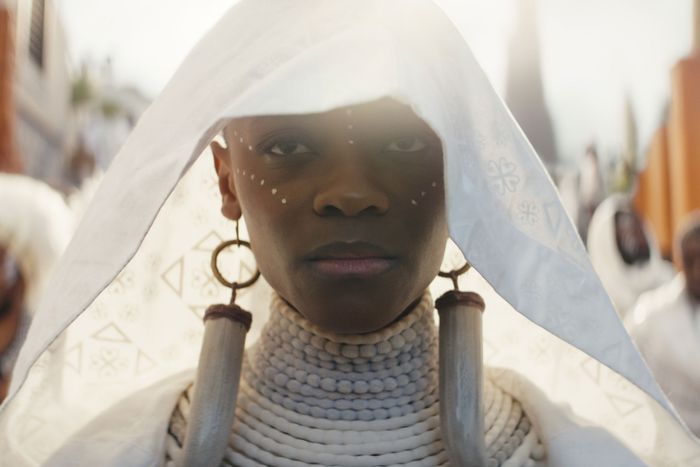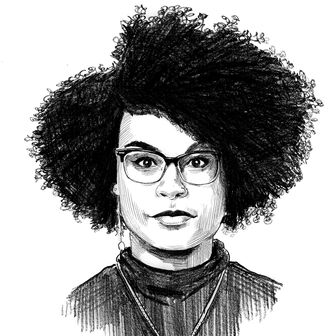
Black Panther: Wakanda Forever carries a series of burdens no one film could ever bear. Its director, Ryan Coogler, must grapple with the challenges and expectations born and influenced by the tragic death of star Chadwick Boseman. Coogler must craft an entertaining sequel to a billion-dollar blockbuster while working within the constricting Marvel Cinematic Universe. He must carefully balance the expectations of Black folks who have elevated the film to a celestial status — a pinnacle of Afrofuturism-tinged desires for a specific kind of Black power and representation onscreen. The film is called to respectfully introduce a new Black Panther and push the MCU forward with the introduction of Namor (Tenoch Huerta), an Indigenous Mesoamerican king-god figure of the undersea, isolationist kingdom Talokan — which has its own cache of vibranium and superhuman strength that makes Wakanda buckle. Perhaps most crucially, the film’s cast must act out grief while being mired in the experience themselves, which is especially true for Letitia Wright’s Shuri, who is tasked with shouldering the film’s most dramatic moments.
To say the film is overtaxed is an understatement. Regrettably, Black Panther: Wakanda Forever tries to do so many things that it comes across as threadbare and pallid — less a failure of imagination and more of circumstance, time, and narrative constraints.
I have complicated feelings around the original Black Panther, which was released to great acclaim in 2018. I’ve never gravitated to the mythos, primarily because T’Challa is a character of such noble stature that he can come across as uncomplicated, too perfect, and lacking the human foibles that make a character root themself in your memory. (In a surprising moment of self-awareness for the franchise, a cameo in Wakanda Forever says as much.) But Boseman rounded out T’Challa with a sweetness he aimed toward the character’s loved ones, which makes the actor’s absence in Black Panther: Wakanda Forever even more profound. Without him, the sequel struggles to hit the graceful emotional frequencies of its predecessor. The Marvel framework tends to falter when it comes to portraying genuine, complicated feelings, and what is more complicated than grief? It lacks a linear quality. It isn’t something you can overcome with a magic spell or godlike abilities. It breaks against the form and function of a Marvel property.
Wakanda Forever begins with the funeral of T’Challa — a sight tinged with joy and sorrow. Here, the film is at its most vivid and visually intriguing. T’Challa’s coffin is carried through the capital of Wakanda by the tearful Dora Milaje led by Okoye (Danai Gurira). The cortège and people of Wakanda are dressed in all white — a striking touch from costuming legend Ruth E. Carter. While the faces of T’Challa’s closest loved ones are solemn, the people of Wakanda move their bodies in an ecstatic dance slowed down to the speed of molasses. But the scene is all too brief. The editing, which gives the film a rushed quality here and a lethargic one elsewhere, works against what the sequence accomplishes. We’re soon jettisoned into the thrust of the story (although thrust is perhaps too forceful a word to describe such an anemic film).
In the wake of T’Challa’s death from an unnamed illness, his mother, Queen Ramonda (Angela Bassett), must help her empire navigate assaults from within and without. The true might of Wakanda is now widely known, and the film tries to spell out the geopolitical consequences of this new reality. In doing so, it turns to its lone white folks — Everett K. Ross (an annoyingly nondescript Martin Freeman functioning as living exposition) and Valentina Allegra de Fontaine (a hard-edge but not altogether engaging Julia Louis-Dreyfus) — and screeches into the land of boredom and obligation. They soon learn that an even greater threat than Wakanda is Talokan — led by Namor, who is eager to fight against the surface world in order to protect his kingdom. (How many isolationist societies of magical, powerful people of color can one cinematic universe have?) Namor isn’t so much a villain as a misshapen antagonist forced into violence by a script that requires it to push the plot along, yet he cares deeply for the barely sketched supporting figures of his kingdom.
The beating heart of the film is meant to be Shuri, who is pulled in as many directions as the story itself: between grief-fueled vengeance and growth, between chaos and peace. The sharp-mouthed, highly intelligent younger-sister archetype that Shuri filled never quite worked for me, but graduating her to a character saddled with so much devastation doesn’t either. Wright can’t find the intensity required, and she lacks the physicality to stand out in frames filled with more forceful actors. Lupita Nyong’o fares much better. I’ve missed the sight of her onscreen. Her brightness as Nakia infuses a few beautiful moments in the film. Other characters feel mostly surface-level in comparison: never fully rounded out with their own moments of bereavement or a fully rooted personality. Consider the spunky college student Riri Williams (Dominique Thorne), who is weighted down by the clunkiest jokes of the film. Gurira and Bassett, however, when given the space to do so, capably provide the complex characterization that is otherwise sparse — as a stunning moment in the kingdom’s throne room, shot through with anger and deep longing, demonstrates.
There’s a lot of wasted talent onscreen. Michaela Coel’s character, Aneka, is missing the tricksy magnetism the writer-actor displays everywhere else. The look of Namor is beguiling — as are the ideas behind his Talokan lineage (he was born in the 16th century and witnessed, as a young child-king, the morally repugnant, heartbreaking violence of Spanish conquistadors). But despite the film’s nearly three hours, there is seemingly not enough time to flesh out his people and culture. It constructs a rushed origin story never focused enough on building out Talokan. Who are its people beyond their isolationism? What do they worship and delight in? What powers their beliefs in a world where a godlike being like Namor exists? Within this part of the film’s tapestry, no character possesses a hint of interiority. Rather than a sincere exploration of this Indigenous world, Namor’s character plays like a cunning decision to broaden Disney and Marvel’s target audience under the banner of representation (despite Huerta’s clear commitment and pleasure in the role). When Huerta is called to deliver lines with the word mutant, they land with a thud.
The action scenes provide little of the decadent thrills that can power even the emptiest of superhero narratives. In the first Black Panther, the action aims for a muscular kineticism that mostly succeeds when characters like Killmonger are unmasked or the camera is trained on Okoye and the Dora Milaje. The fight choreography of the original has clean, strong lines of action and emotional beats that bring with them a scintillating force that Wakanda Forever fails to achieve. Here, the muscular kineticism has been replaced with an ostentatious grandiosity. The final fight scene, in particular, is impressive in terms of the scope and amount of actors involved onscreen, but it lacks the precision and focus that would lead to standout moments. Scenes involving members of the Dora Milaje are blocked in ways that render their physical presence much less graceful, stifling any glimmer of characterization the movement of the first film provided. The choreography of the Talokan fighters isn’t distinct enough either — save for in fits and spurts like during a fight with Okoye on a city bridge. Namor is powerful, to be sure, but his introductions in scenes lack the regality that could make an undersea king feel fantastically unreal. The new Black Panther is meant to flex their muscles in the back half, but by then, an overstuffed quality has set in. The dexterous bliss that comes with the sudden explosion of superheroic energy is crowded out. Ultimately, Coogler and cinematographer Autumn Durald Arkapaw lose sight of the rich color and minute detail that make this comic world alluring and, instead, allow their picture to feel as busy as the gold-and-black costume of the new Black Panther.
Wakanda Forever is too drab to work as a capable sequel, too unfocused to feel wholly consequential among the spoiling bombast of the larger MCU, too surface-level in its characterization and thematic entanglements to function as a worthy memorial to a star gone far too soon. It is neither developed enough narratively nor complex enough politically. It is a film not about Blackness or Indigenous identity, though it hides behind the sheen of both. Coogler is a strong director still relatively early in his career, but his voice isn’t evolving as much as it’s rattling inside the morass of the ever-growing MCU. Who does Coogler want to be as an artist? What does he have to say about humanity? Black Panther: Wakanda Forever doesn’t have the answers.
More Movie Reviews
- An Exploited Neighborhood, Seen Through Children’s Eyes
- Challengers Is Almost a Sexy Movie
- Zack Snyder’s Screensaver Space Opera Comes to an Uneventful End





